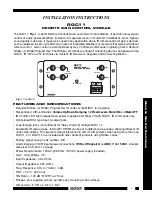
Boomer-III User Manual & Integrator’s Guide_________________________________________________Installation
BM310012WT04
53
Copyright Wavenet Technology © October 2003
Availability is an issue, as most suppliers do not sell cells, but
force customers into particular solutions through their battery
pack designs. Purchasing cells in an effort to design your own
battery pack may be problematic due to cell lead times.
Li-ion does not exhibit the memory effect and is unaffected by
partial discharging-charging cycles
Internal impedance of 100-150m
Ω
per 3.6V cell. Li-ion
batteries are very susceptible to damage due to over discharge
and high current pulses. As a result, manufacturers recommend
that a protection circuit be added to battery pack designs. The
resultant internal impedance of a battery pack with protection
circuitry can reach the 500m
Ω
level.
Typical cell voltages are 3.6V with multiple cells used to obtain
higher operating voltages.
Li-ion batteries are very sensitive to over-discharge and
represent a hazard if not properly designed with protection
circuitry.
Typical charge method is constant-voltage, constant-current.
Applying Battery Technologies
When reviewing different battery technologies, consider the following
characteristics of OEM devices incorporating wireless data modems.
Current drain is not constant
Typically, battery manufacturers specify the battery discharge profiles
by assuming a constant-current drain model. In a wireless data system,
the constant current drain model no longer applies. There are three
levels of current drain contributions that can be expected: sleep,
receive, and transmit. The modem cycles through these different states
throughout the time it is powered on and in contact with the wireless
network. To determine the realistic battery life or capacity for your
product, you must contact the battery manufacturer or experiment by
transmitting for various durations.
Peak currents during transmissions
Since transmissions are typically short, the resultant current drain
during transmissions can be viewed as current pulses. These pulses
must be considered when selecting the proper battery technology, since
not all technologies are equally tolerant of current pulses.
Additionally, the internal impedance of the battery must be taken into
account at the peak currents during transmissions, since this is the time
when the largest voltage drop occurs across the battery terminals.
Adequate supply guard-band must be designed in to ensure that the
modem and any other circuitry in the final product are not reset during
transmissions.
















































